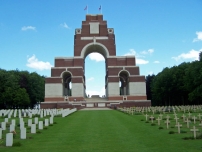| First Name: | George | Last Name: | COLLINS | |
|---|---|---|---|---|
| Date of Death: | 06/07/1916 | Lived/Born In: | Dalston | |
| Rank: | Private | Unit: | Royal Welsh Fusiliers15 | |
| Memorial Site: | Thiepval Memorial, France | |||
Current Information:Age-18 79, Norfolk Road, Dalston The Battle of the Somme (July-November, 1916) On 1st July 1916 The British Army launched a massive offensive along a section of the front line running north of the River Somme. The French attacked south of it. The first day was a disaster for the British army which suffered nearly 60,000 casualties, 19,000 of whom were killed, and made hardly any inroads into the enemy lines. But the battle had to go on, if for no other reason than to relieve pressure on the French at Verdun where they had been facing the full onslaught of the powerful German Army. So it continued all the way through to November with nearly every battalion and division then in France being drawn into it at some stage. In the end the German trenches had been pushed back a few miles along most of the line but the cost in lives had been staggering. By the end of the fighting in November, 1916, British Army casualties numbered over 400,000, killed, wounded and missing. The days immediately following the carnage of July 1st on the Somme, had two main priorities. They were to rescue the wounded and to consolidate what gains had been made. However, despite the slaughter of 1st July, there was no going back. This was the “Big Push” and the attacks had to continue and Haig decided that they would continue on the southern sector of the front where the few successes had occurred. The first two weeks of the battle saw Fourth Army pushing forward towards the German second line from Contalmaison, through Mametz Wood to Trones Wood. The problem was that these attacks were uncoordinated, with divisions and corps operating independently and without direction from Army HQ. In a series of isolated operations the British Army struggled forward and took territory but the price in human life was far higher than it should have been. An example of this was the attack made by 38th (Welsh) Division against Mametz Wood. On 5th July 1917, they moved up to positions north-west of Montauban in preparation for this attack which was launched on 7th July. In the face of well sited German machine guns and the battle hardened Lehr Regiment of the Prussian Guard the attack failed but so displeased were the high command that they sacked the divisional commander The next two days were spent holding their forward positions and re-organising and then on 10th July they attacked once more. After two days of bitter fighting the wood was cleared of Germans but the cost to 38th Division had been exceedingly high with nearly 4,000 casualties. 15th Royal Welsh Fusiliers had been formed in London and were part of 113 Brigade of 38th Division. On 6th July they were in position, ready for the attack on Mametz Wood the following day. The enemy, aware of these developments, bombarded the British front line in front of Mametz Wood almost continuously and it is more than likely that George Collins was killed by this artillery fire. |
||||
| « Back to Search Results | ||||
| If you think any of the information shown here is incorrect, Click Here to submit your amends and comments | ||||




